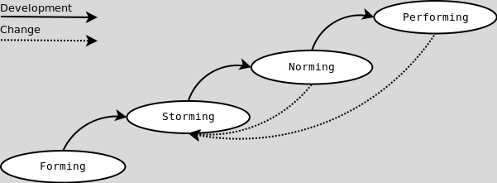Firefighting happens usually during bug fixing and at the end of projects, when the project may or may not be as successful as people want it to be. In this particular post, I’m going to talk about the latter case.
Usually, when the project is in trouble, management offers more (human) resources in order to finish the project in time and deliver the committed scope. Based on Brooks’ Law, this is not a wise decision, but it happens all the time.

According to Brook, the amount of new man-power is not directly proportional to the team’s performance (see figure). The possible reasons for performance degradation are:
-
increased communication
-
increased coordination effort
-
unwanted diversity inside the team
-
bringing new people up to speed
Scrum masters and team leaders are usually reluctant to accept such a change inside their teams for obvious reasons. In most cases they have no other choice but to take the new people into the team and try to do their best. This is a change inside the team, and we have now arrived at Tuckman’s stages of group development:

With the new people on board the team, it does not matter in which stage the team is right now, it goes back to storming stage. Now the team has to deal with
-
the costs of increased communication and coordination effort
-
the costs of development to norming and performing stages
-
the costs of finishing the project in time
This overhead is so huge that failure is guaranteed. Seems to be a lose-lose situation. By rejecting the additional resources, the team is facing a conflict with management, which is time consuming. Again: lose-lose.
If a scrum master or a team leader faces a situation like this, I would say that he should accept the additional resources and form a new team with only one single purpose: to find out what went wrong and what needs to be changed so that the original team can finish the project in time. With this approach, the integrity of the original team won’t be damaged, as opposed to the scenario described above, and the single purpose guarantees that the new team will perform. This task is a creative one, therefore there is no need to motivate the new team with money:
In most cases people do not like changes, so they’ll do everything in order to avoid or minimize them. There are two changes here:
-
the additional people have to switch teams
-
the original team has to deal with the new members
Both of the parties are motivated to go back to their original states: source team and original team setup. There is no need for money here as motivator. One can ask how long this new team shall work together. In the agile world - among other things - time boxing is very important. I would say that this new team shall work together on the problem for 2-5 days. One day is not enough for the forming stage and more than a week risks the whole project. Of course, the new setup can work together on the project during this period, but the single purpose (root cause analysis and plan for proceeding) shall be the most important thing for them.
This approach turns the lose-lose situation into a win-win situation; management is happy, because their idea - new resources on board - is implemented, and the team is also happy, because they can stay together after finding the root cause of the problems and finding a way to finish the project.
comments powered by Disqus